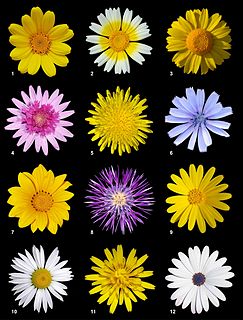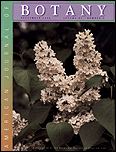
The Dioscoreales are an order of monocotyledonous flowering plants in modern classification systems, such as the Angiosperm Phylogeny Group and the Angiosperm Phylogeny Web. Within the monocots Dioscoreales are grouped in the lilioid monocots where they are in a sister group relationship with the Pandanales. Of necessity the Dioscoreales contain the family Dioscoreaceae which includes the yam (Dioscorea) that is used as an important food source in many regions around the globe. Older systems tended to place all lilioid monocots with reticulate veined leaves in Dioscoreales. As currently circumscribed by phylogenetic analysis using combined morphology and molecular methods, Dioscreales contains many reticulate veined vines in Dioscoraceae, it also includes the myco-heterotrophic Burmanniaceae and the autotrophic Nartheciaceae. The order consists of three families, 22 genera and about 850 species.
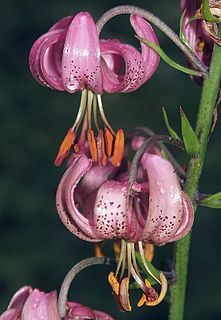
Liliales is an order of monocotyledonous flowering plants in the Angiosperm Phylogeny Group and Angiosperm Phylogeny Web system, within the lilioid monocots. This order of necessity includes the family Liliaceae. The APG III system (2009) places this order in the monocot clade. In APG III, the family Luzuriagaceae is combined with the family Alstroemeriaceae and the family Petermanniaceae is recognized. Both the Lililiales order and the Liliaceae family have had a widely disputed history, with the circumscription varying greatly from one taxonomist to another. Previous members of this order, which at one stage included most monocots with conspicuous tepals and lacking starch in the endosperm are now distributed over three orders, Liliales, Dioscoreales and Asparagales, using predominantly molecular phylogenetics. The newly delimited Liliales is monophyletic, with ten families. Well known plants from the order include Lilium (lily), tulip, the North American wildflower Trillium, and greenbrier.
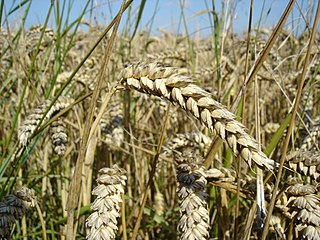
Monocotyledons, commonly referred to as monocots, are flowering plants (angiosperms) the seeds of which typically contain only one embryonic leaf, or cotyledon. They constitute one of the major groups into which the flowering plants have traditionally been divided, the rest of the flowering plants having two cotyledons and therefore classified as dicotyledons, or dicots. However, molecular phylogenetic research has shown that while the monocots form a monophyletic group or clade, the dicotyledons do not. Monocotyledons have almost always been recognized as a group, but with various taxonomic ranks and under several different names. The APG III system of 2009 recognises a clade called "monocots" but does not assign it to a taxonomic rank.
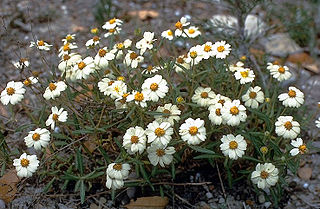
Melampodium is a genus of flowering plants in the sunflower family.

Leontodon is a genus of plants in the dandelion tribe within the sunflower family (Compositae), commonly known as hawkbits.
Eremothamnus marlothianus is a species of shrub in the family Asteraceae, the only species in the genus Eremothamnus. It is native to the coastal desert of Namibia. It is a small shrub with spiny leaves.

Barnadesioideae is a subfamily of flowering plants in the aster family, Asteraceae. It comprises a single tribe, the Barnadesieae. The subfamily is endemic to South America. Molecular evidence suggests it is a basal clade within the family, and it is monophyletic.

The Cichorioideae are a subfamily of the family Asteraceae of flowering plants. Familiar members of Cichorioideae include lettuce, dandelions, chicory and Gazania species. The subfamily comprises about 240 genera and about 2900 species. It is heterogeneous and hard to characterize except with molecular characters.
Isocarpha (pearlhead) is a genus of flowering plants in the sunflower family. They are native to Mexico, Central America, the West Indies, and northern South America, with the range of one species extending north into the United States.

Helminthotheca echioides, known as bristly oxtongue, is a stiff annual or biennial herb native to Europe and North Africa. It was traditionally used as an antihelminthic treatment.

Thelesperma is a genus of North American and South American plants in the cosmos tribe within the sunflower family. Greenthread is a common name for plants in this genus.

Schlechtendalia is a genus of South American plants in the Barnadesieae within the daisy family. It is known in Portuguese as bolão de ouro, meaning "gold bullion". It is a perennial herbaceous plant, with rigid, linear leaves with a pointy tip. The corollas of the florets are yellow, and of the subbilobiate type, with four lobes merged into a strap, but split into teeth over half as deep, and one lobe free. This species flowers from September to December and the fruits are ripe in January or February. The only known species is Schlechtendalia luzulifolia, native to southern Brazil, Uruguay, northern Argentina. This species has sixteen chromosomes (2n=16).

Chrysogonum is a genus of flowering plants in the daisy family found only in eastern North America. Confusion regarding species that were named in Chrysogonum from other parts of the world, such as Madagascar, was clarified by Stuessy who reduced the genus to having only a single species with two varieties. A similar treatment was proposed by Nesom, although in that treatment 3 varieties were accepted. The plants are low-growing terrestrial herbs with yellow flower heads containing both disc florets and ray florets. The genus is distinctive in having pistillate ray florets and staminate disk florets, and the pistil of the ray floret is fused to the adjacent phyllary as well as 3 paleae and their associated disk florets to form a "cypsela complex". The species is grown as an ornamental plant under the common name of Green and Gold, and is used primarily as a ground cover.

Scorzoneroides autumnalis, commonly called autumn hawkbit, is a perennial plant species, widespread in its native range in Eurasia, and introduced in North America.

Lilioid monocots is an informal name used for a grade of five monocot orders in which the majority of species have flowers with relatively large, coloured tepals. This characteristic is similar to that found in lilies ("lily-like"). Petaloid monocots refers to the flowers having tepals which all resemble petals (petaloid). The taxonomic terms Lilianae or Liliiflorae have also been applied to this assemblage at various times. From the early nineteenth century many of the species in this group of plants were put into a very broadly defined family, Liliaceae sensu lato or s.l.. These classification systems are still found in many books and other sources. Within the monocots the Liliaceae s.l. were distinguished from the Glumaceae.

The Amaryllidaceae are a family of herbaceous, mainly perennial and bulbous flowering plants in the monocot order Asparagales. The family takes its name from the genus Amaryllis and is commonly known as the amaryllis family. The leaves are usually linear, and the flowers are usually bisexual and symmetrical, arranged in umbels on the stem. The petals and sepals are undifferentiated as tepals, which may be fused at the base into a floral tube. Some also display a corona. Allyl sulfide compounds produce the characteristic odour of the onion subfamily (Allioideae).
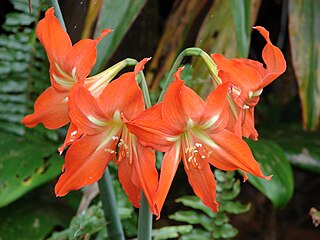
Hippeastreae is a tribe of plants belonging to the subfamily Amaryllidoideae of the Amaryllis family (Amaryllidaceae). Species in this tribe are distributed in South America. Flowers are large and showy, zygomorphic, with the stamens in varying lengths, inflorescence bracts are often fused basally. The seeds are flattened, winged or D-shaped. Reported basic chromosome numbers are x= 8-13, 17, and higher. All the species in this tribe present a remarkable aesthetic interest and horticultural value.

The taxonomy of Liliaceae has had a complex history since the first description of this flowering plant family in the mid-eighteenth century. Originally, the Liliaceae or Lily family were defined as having a "calix" (perianth) of six equal-coloured parts, six stamens, a single style, and a superior, three-chambered (trilocular) ovary turning into a capsule fruit at maturity. The taxonomic circumscription of the Liliaceae family progressively expanded until it became the largest plant family and also extremely diverse, being somewhat arbitrarily defined as all species of plants with six tepals and a superior ovary. It eventually came to encompass about 300 genera and 4,500 species, and was thus a "catch-all" and hence paraphyletic taxon. Only since the more modern taxonomic systems developed by the Angiosperm Phylogeny Group (APG) and based on phylogenetic principles, has it been possible to identify the many separate taxonomic groupings within the original family and redistribute them, leaving a relatively small core as the modern Liliaceae family, with fifteen genera and 600 species.


